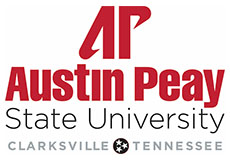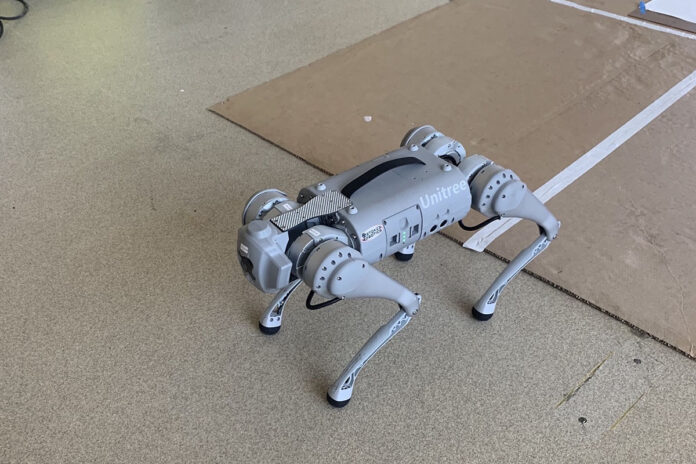 Clarksville, TN – This summer, the Austin Peay State University (APSU) College of STEM purchased a robotic dog to enhance the learning experience for students in the Department of Engineering Technology and the Department of Computer Science and Information Technology.
Clarksville, TN – This summer, the Austin Peay State University (APSU) College of STEM purchased a robotic dog to enhance the learning experience for students in the Department of Engineering Technology and the Department of Computer Science and Information Technology.
The robot dog utilizes a variety of functions that incorporate many different scientific specializations. This technology has the potential to excite and engage students in ways never before seen on APSU’s campus.
“The capabilities of the quadruped robot are something that we are interested in,” said Jody Alberd, an assistant professor in the APSU Department of Engineering Technology. “It was something we knew we could collaborate with the computer science program on and both departments could benefit from it.”
The robot dog has the capacity for advanced programming languages, including C++ and Python. Students will be given the opportunity to program the robot using these languages to perform specific tasks and follow instructions based on environmental cues. In turn, the robot is capable of learning from and engaging with its surroundings based on advanced student programming in a variety of programming languages, promoting hands-on learning experiences for APSU students.
“In the APSU College of STEM, we understand the importance of collaboration and real-world experiences to better prepare our students for their careers after graduation,” said Karen Meisch, Dean of the APSU College of STEM. “This robot dog incorporates robotics, coding, engineering, physics, mechatronics and technology in ways that will challenge our students to think creatively and approach new challenges in an innovative way. It also does it in a way that is fun.”
In addition, the robot features an all-inclusive package meant to enrich the education of students within the College of STEM, regardless of their specializations or knowledge of robotics.
The ultimate goal is for the robot dog to engage students and faculty unconventionally. According to Alberd, the Department of Engineering Technology hopes that all departments will recognize its potential and take advantage of the new learning opportunities.
“The hope and the intent is that all the departments will think outside the box,” Alberd said. “We feel that there’s a lot of capability and potential in this robot and that other departments that might not normally consider robotics might consider exploring what new uses can be done with it.”
The robot was purchased for several STEM departments, including engineering technology, computer science, physics, and astronomy. By allowing each department access to the robot, its potential uses can be recognized and developed through student and faculty collaboration.
“For example, let’s say the APSU Department of Agriculture doesn’t have the resources to invest in robots, but maybe they want to explore the potential of this robot to help them with their program and to expose that information to their students,” Alberd said. “That was really the intent. For the departments to think outside the box and find ways to collaborate with us. To do things that we wouldn’t normally expect when you think of robotics like this.”
The robot’s potential uses are further emphasized in its programming, which features both artificial intelligence (AI) and remote capabilities. The robot contains the programming capacity to perform actions through AI as well as the ability to be controlled remotely through an operator. It also includes a sensor package that allows it to analyze the environment and interact with it appropriately.
“We can challenge our students to program specific tasks within that environment–look at the environment and then function and interact with that environment in a number of different ways,” Alberd said.
The robot’s main purpose is to engage students in the classroom through interactive opportunities. By integrating the robot into the classroom throughout the College of STEM, students can see their work pay off while gaining hands-on experience.
“In terms of the classroom environment, to sum it all up, we have the existing curriculum for programming and for robotics, and we want to incorporate this as the next level to get students interested and to provide opportunities for them to work on their own on personal research,” Alberd said.
Ethen Carrell, a graduate student at Austin Peay State University, is the first student to work directly with programming the robot dog. He is pursuing a master’s degree in computer science and quantitative methods, focusing on predictive analytics.
Carrell is particularly excited about the potential of custom programming to enhance the robot’s capabilities and make it more interactive. He is working with Dr. John Nicholson, a Department of Computer Science and Information Technology professor, on the research.
“We really want to make our own custom programming so that we can make our own demos for it to do things without having to use a controller,” he said. “That’s the goal … I’m going to be putting in blood, sweat, and tears getting it to work properly. I hope everybody gets a chance to use it.”
The robot dog is also a key factor in student outreach for the College of STEM and has garnered significant interest among current and potential APSU students.
“As an outreach tool, it’s incredible and it gains interest in STEM,” Alberd said. “It gets [students] interested in what we have here at Austin Peay. When they get here as students, we can offer them the opportunity for them to learn more.”
The robot has made appearances at camps throughout the summer where students were allowed to test it out. The easy-to-use controls have further bolstered interest in the robot, enticing students to learn more about Austin Peay’s STEM programs.
The Austin Peay State University Department of Engineering Technology hopes to push the limits of the robot in the future and encourage students to discover all of its capabilities. The department is also looking into purchasing similar robots to explore their potential in comparison to the robot dog, specifically regarding collaborative robotics.
“There are other robots of this style and this design, quadruped, that have greater capabilities out there that we can grow into,” Alberd said. “I’ve thought about the potential of pushing the limits of it, reaching what we can with this one, and then beginning to work with them integrating together. One robot on its own is impressive; two robots working collaboratively are incredibly impressive.”
Alberd said he hopes students will eventually use the robot dog as a foundation to design, program and build their own robots.
“I would love to, at some point, look into, once students have figured out what they can do with this one, designing their own,” Alberd said. “That’s really the next step after this is going to be designing their own and creating their own unique research and unique robots.”The technology behind the robot dog is very prevalent in modern robotics, and the College of STEM is providing students the opportunity to discover and exceed its limitations.
“We want to be cutting-edge–it’s Austin Peay State University,” Alberd said. “We want to be at the forefront of what new technology is out there, and this is one of the pieces of technology that is just starting to come to the public’s attention. We want to lead the way in helping people understand it, learn how to control it, and operate it. The best way to do that is to have it and put it in the hands of our students.”



